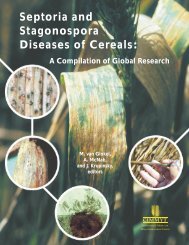Section 3 (Crop Management)
Section 3 (Crop Management)
Section 3 (Crop Management)
Create successful ePaper yourself
Turn your PDF publications into a flip-book with our unique Google optimized e-Paper software.
Labios et al.<br />
Figures 3 and 4 showed that zero tillage resulted to the highest gross return when used with both<br />
fertilizer levels. Likewise, it also incurred the lowest production costs, thus higher net benefits. On the<br />
other hand, conventional tillage gave the second best gross returns when also applied with both fertilizer<br />
levels but entailed higher costs for land preparation and for other labor inputs, hence posting smaller net<br />
returns. Added benefits are, however, obtained with zero tillage in terms of reduced losses in soil<br />
moisture with the undisturbed soil surface. This is especially relevant in the study site in as much as water<br />
becomes a serious constraint during the dry season.<br />
Figures 5a-5d shows the corn stand at various growth stages and field operations under Conservaton<br />
Tillage technology in San Jose, Mindoro Occidental.<br />
Camarines Sur<br />
Table 3 shows the ANOVA of grain yield under tillage by variety trial obtained in Brgy. Sibao,<br />
Calabanga, Camarines Sur. It can be observed that no significant effect was observed on the main effects<br />
of tillage and variety. Similarly interaction between tillage and variety shows no significant effect on<br />
grain yield.<br />
Although tillage practices do not significantly affect yield, Table 4 shows that the highest grain yield<br />
was obtained from zero tillage practice with 2.88 t ha -1 followed closely by minimum tillage with 2.78 t<br />
ha -1 . Farmer’s tillage practice, likewise, ranks last with only 2.73 t ha -1 .<br />
Summary of cost and return reveals that benefits obtained in adopting zero tillage is further realized<br />
in terms of economic returns. From the graphs presented in Figure 6, it was evident that the highest net<br />
income was obtained from zero tillage, which is mainly due to the reduced labor cost brought about by<br />
land preparation.<br />
Other project considerations<br />
After just one cropping season of on-farm research (dry season of 1999 –2000) in San Jose, these<br />
alternative technologies are spreading to other villages in San Jose and to the municipalities of Sablayan<br />
and Sta. Cruz during the dry season of 2000-2001, with support from the local government unit (LGU) at<br />
the municipal and provincial levels. The area for corn production in the province is almost double that of<br />
the previous year and the number of corn farmers have increased significantly during the same period.<br />
More traders and feed millers are now becoming more active in the San Jose area. This has been made<br />
possible through collaborative efforts among the provincial and municipal LGUs of Mindoro Occidental,<br />
the Southern Tagalog Integrated Agricultural Research Center (DA-STIARC), MONSANTO Philippines,<br />
Inc., and the UPLB on-farm research group.<br />
The same trend happened in Sibao where the LGU expanded the technology to other barangays with a<br />
collaborative efforts among the provincial and municipal LGUS of Camarines Sur, the Bicol Integrated<br />
Agricultural Research Center (BIARC), MONSANTO Philipines, Inc., and the UPLB on-farm research<br />
group.<br />
Conclusion<br />
In the case of Mindoro Occidental, the highest yield of yellow corn (var C818) was obtained using<br />
zero tillage compared to conventional and farmers’ tillage practices. This resulted to higher net returns<br />
mainly due to lower production cost. Reducing the rate of fertilizer application to half of the<br />
recommended rate plus application of 1 kg ha -1 BIO-N combined with zero tillage contributed to the<br />
increase in net income of the farmers compared to other treatments.<br />
- 299 -









